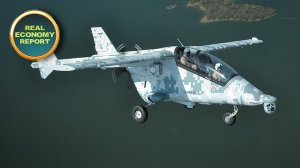From Creamer Media in Johannesburg, this is the Real Economy Report.
Sashnee Moodley:
South African defence platforms company Paramount Group announced in September its plans to begin full scale manufacture of its Ahrlac fixed-wing aircraft at a 15 000 m2 purpose-built facility at Wonderboom Airport, north of Pretoria. Dylan Slater tells us more
Dylan Slater:
The new manufacturing facility is a dual-workshop facility, whereby one portion of each Ahrlac will be made in one half of the factory, while the remainder of the airframe will be completed in the other half of the factory, thereby bringing full line-production from the factory to two airframes a month. Paramount Group have also earmarked land at the airport for the possible expansion of the factory should production need to be ramped up further.
Ahrlac test co-pilot Paul Potgieter explains the capabilities of Ahrlac to potential clients
Ahrlac test co-pilot Paul Potgieter:
Dylan Slater:
With the Ahrlac manufacturing programme set to begin in early 2017, Potgieter explains how Paramount Group will be undertaking the project
Ahrlac test co-pilot Paul Potgieter:
Dylan Slater:
In other news, South African defence group Denel launched its conceptual Africa Truck demonstrator during this year’s Africa Aerospace & Defence expo, which took place at Waterkloof Airforce Base in Pretoria, during September.
BAE Systems business development manager Hennie Smit explains the development of the concept
BAE Systems business development manager Hennie Smit:
Dylan Slater:
Considering the new truck concept is called the Africa Truck, there exists the potential to market the conceptual modular design to other African countries or even international clientele. I asked Smit whether there are plans to broaden the market for the Africa Truck in the future
BAE Systems business development manager Hennie Smit:
Dylan Slater:
Also making an appearance at this years Africa Aerospace & Defence was aerospace components manufacturer AAT Composites, which showcased its ability to meet strict international aircraft original equipment manufacturing protocols, thereby developing a range of internal and external components for aircraft.
AAT Composites innovation and portfolio senior manager Dr Louis Tredoux explains that the company undertook several work packages for aircraft manufacturer Pilatus earlier this year
AAT Composites innovation and portfolio senior manager Dr Louis Tredoux:
Dylan Slater:
Tredoux also explains some of the latest trends in the aircraft components manufacturing sector at the moment
AAT Composites innovation and portfolio senior manager Dr Louis Tredoux:
Sashnee Moodley:
Other news making headlines this week.
South African hazardous-waste landfill sites have a new best-practice champion in multinational waste-management company Averda’s R250-million Vlakfontein high-hazardous-class landfill site, in the Vaal Triangle. David Oliveira has the story.
David Oliveira:
Averda MD Johan van den Berg told media during a site visit that Vlakfontein is the first landfill site of its kind in South Africa to comply with the new Waste Classification and Management regulations, which came into effect in August 2013.
Averda MD Johan van den Berg
David Oliveira:
It is also the first landfill site to be constructed to the standards prescribed by the Waste Classification and Management regulations for Class A containment barriers, and the first high-hazard landfill site to be developed locally in 20 years.
Averda logistics head Brent Mahoney
David Oliveira:
Vlakfontein’s effectiveness comes from its design, and barrier technology, which prevents hazardous materials entering the environment.
The barrier, or liner, comprises a 1.2-m-deep multilayered solution of compacted clay, high-density polyethylene, stone and geotextiles.
The solution is designed to not only prevent harmful waste seeping into the soil but also drain and capture environmentally harmful liquids, known as leachate.
Leachate from Vlakfontein’s 500 000 m3 Cell 1 site, which started accepting waste in May this year, is gravity-fed into two 5 000 ℓ tanks. Once the tanks reach capacity, the leachate is pumped up to the leachate dam.
Vlakfontein will have six cells providing 6 500 000 m3 of landfill capacity. The cells will be constructed in a phased approach according to the rate at which preceding cells are filled. The site has a 30-year life span.
Averda technical manager Neville Chetty
David Oliveira:
Meanwhile, companies disposing of waste are required to classify the waste streams according to SANS 10234 before disposal, as per the requirements of the Waste Classification and Management regulations.
SANS 10234 complies with international standards for chemicals classification and labelling the Globally Harmonized System.
Averda technical manager Neville Chetty
Sashnee Moodley:
That’s Creamer Media’s Real Economy Report. Join us again next week for more news and insight into South Africa’s real economy.
Edited by: Creamer Media Reporter
EMAIL THIS ARTICLE SAVE THIS ARTICLE
To subscribe email subscriptions@creamermedia.co.za or click here
To advertise email advertising@creamermedia.co.za or click here












